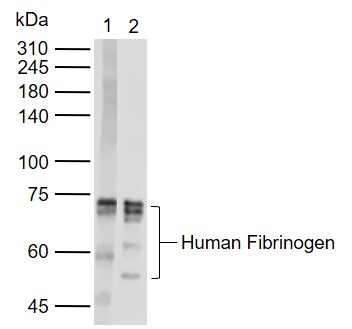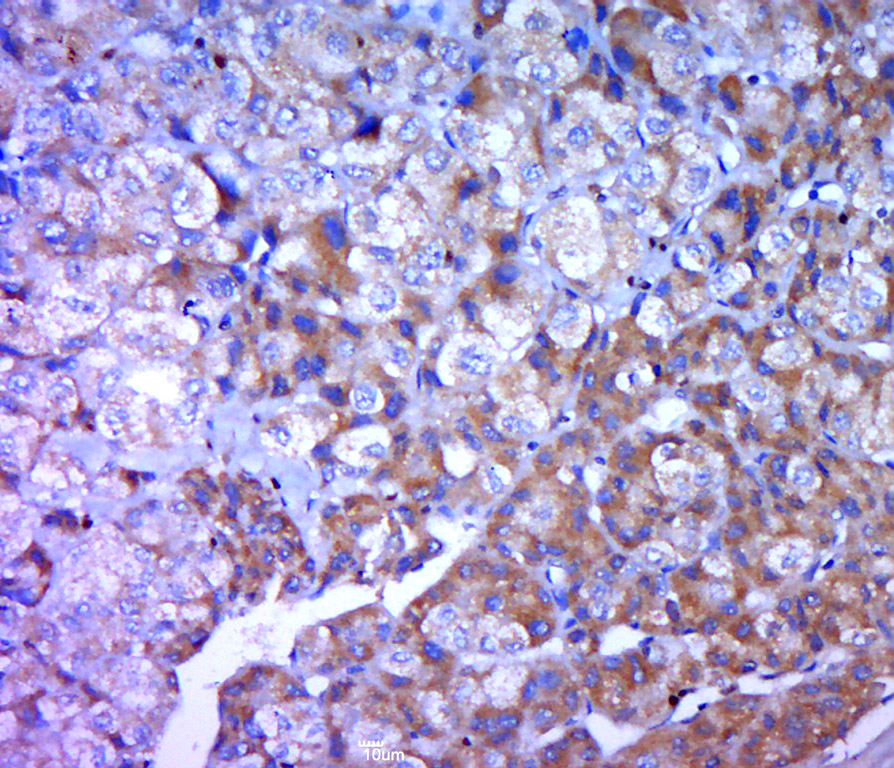
Rabbit Anti-FGA antibody
Fib2; FIBA_HUMAN; Fibrinogen alpha chain; fibrinogen alpha chain isoform alpha preproprotein; Fibrinogen alpha/alpha E chain [Precursor]; fibrinogen alpha chain isoform alpha-E preproprotein;
View History [Clear]
Details
Product Name FGA Chinese Name 纤维蛋白肽A抗体 Alias Fib2; FIBA_HUMAN; Fibrinogen alpha chain; fibrinogen alpha chain isoform alpha preproprotein; Fibrinogen alpha/alpha E chain [Precursor]; fibrinogen alpha chain isoform alpha-E preproprotein; Research Area Cardiovascular Immunogen Species Rabbit Clonality Polyclonal React Species Human, Applications WB=1:500-2000 ELISA=1:5000-10000 IHC-P=1:100-500 IHC-F=1:100-500 ICC=1:100-500 IF=1:100-500 (Paraffin sections need antigen repair)
not yet tested in other applications.
optimal dilutions/concentrations should be determined by the end user.Theoretical molecular weight 1.5/66/91kDa Cellular localization Secretory protein Form Liquid Concentration 1mg/ml immunogen KLH conjugated synthetic peptide derived from human Fibrinopeptide A: 20-120/866 Lsotype IgG Purification affinity purified by Protein A Buffer Solution 0.01M TBS(pH7.4) with 1% BSA, 0.03% Proclin300 and 50% Glycerol. Storage Shipped at 4℃. Store at -20 °C for one year. Avoid repeated freeze/thaw cycles. Attention This product as supplied is intended for research use only, not for use in human, therapeutic or diagnostic applications. PubMed PubMed Product Detail The protein encoded by this gene is the alpha component of fibrinogen, a blood-borne glycoprotein comprised of three pairs of nonidentical polypeptide chains. Following vascular injury, fibrinogen is cleaved by thrombin to form fibrin which is the most abundant component of blood clots. In addition, various cleavage products of fibrinogen and fibrin regulate cell adhesion and spreading, display vasoconstrictor and chemotactic activities, and are mitogens for several cell types. Mutations in this gene lead to several disorders, including dysfibrinogenemia, hypofibrinogenemia, afibrinogenemia and renal amyloidosis. Alternative splicing results in two isoforms which vary in the carboxy-terminus. [provided by RefSeq, Jul 2008]
Function:
Fibrinogen has a double function: yielding monomers that polymerize into fibrin and acting as a cofactor in platelet aggregation.
Subunit:
Heterohexamer; disulfide linked. Contains 2 sets of 3 non-identical chains (alpha, beta and gamma). The 2 heterotrimers are in head to head conformation with the N-termini in a small central domain.
Subcellular Location:
Secreted.
Tissue Specificity:
Plasma.
Post-translational modifications:
The alpha chain is not glycosylated.
Forms F13A-mediated cross-links between a glutamine and the epsilon-amino group of a lysine residue, forming fibronectin-fibrinogen heteropolymers.
About one-third of the alpha chains in the molecules in blood were found to be phosphorylated.
Conversion of fibrinogen to fibrin is triggered by thrombin, which cleaves fibrinopeptides A and B from alpha and beta chains, and thus exposes the N-terminal polymerization sites responsible for the formation of the soft clot. The soft clot is converted into the hard clot by factor XIIIA which catalyzes the epsilon-(gamma-glutamyl)lysine cross-linking between gamma chains (stronger) and between alpha chains (weaker) of different monomers.
Phosphorylation sites are present in the extracellular medium.
DISEASE:
Defects in FGA are a cause of congenital afibrinogenemia (CAFBN) [MIM:202400]. This is a rare autosomal recessive disorder characterized by bleeding that varies from mild to severe and by complete absence or extremely low levels of plasma and platelet fibrinogen. Note=The majority of cases of afibrinogenemia are due to truncating mutations. Variations in position Arg-35 (the site of cleavage of fibrinopeptide a by thrombin) leads to alpha-dysfibrinogenemias.
Defects in FGA are a cause of amyloidosis type 8 (AMYL8) [MIM:105200]; also known as systemic non-neuropathic amyloidosis or Ostertag-type amyloidosis. AMYL8 is a hereditary generalized amyloidosis due to deposition of apolipoprotein A1, fibrinogen and lysozyme amyloids. Viscera are particularly affected. There is no involvement of the nervous system. Clinical features include renal amyloidosis resulting in nephrotic syndrome, arterial hypertension, hepatosplenomegaly, cholestasis, petechial skin rash.
Similarity:
Contains 1 fibrinogen C-terminal domain.
SWISS:
P02671
Gene ID:
2243
Database links:
Entrez Gene: 2243 HumanEntrez Gene: 14161 Mouse
SwissProt: P02671 Human
SwissProt: Q99K47 Mouse
Product Picture
Lane 1: Human Plasma
Lane 2: Human Fibrinogen (from plasma) ( SL1240P)
Primary: Anti-FGA (SL10080R) at 1/1000 dilution
Secondary: IRDye800CW Goat Anti-Rabbit IgG at 1/20000 dilution
Predicted band size: 1.5/66/91 kDa
Observed band size: 52,62,70 kDa
Paraformaldehyde-fixed, paraffin embedded (human liver carcinoma); Antigen retrieval by boiling in sodium citrate buffer (pH6.0) for 15min; Block endogenous peroxidase by 3% hydrogen peroxide for 20 minutes; Blocking buffer (normal goat serum) at 37°C for 30min; Antibody incubation with (Fibrinopeptide A) Polyclonal Antibody, Unconjugated (SL10080R) at 1:400 overnight at 4°C, followed by a conjugated secondary (sp-0023) for 20 minutes and DAB staining.
Bought notes(bought amounts latest0)
No one bought this product
User Comment(Total0User Comment Num)
- No comment




 +86 571 56623320
+86 571 56623320
 +86 18668110335
+86 18668110335

